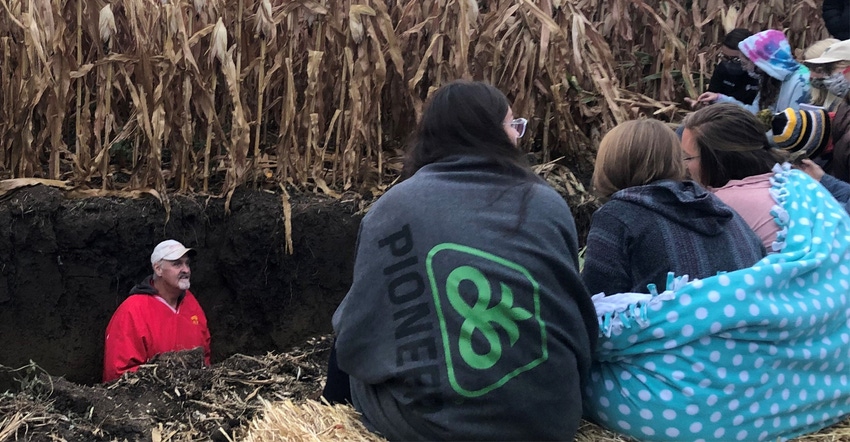November 11, 2020

The summer of 2020 in northwest Iowa was a dry one. During each summer, I use the Mesonet Climodat Station Monitor to watch weather patterns at 11 weather stations in the region I serve. This data showed from the start of planting on April 15 to crop maturity about Sept. 15, these weather stations received 6 to 9 inches less rain than normal. Most have been over 2 inches below normal since then. The current drought monitor puts this area in the severe to extreme drought.
I believe the most limiting yield factor for this region this year has been lack of water during the growing season. Yet yields mostly have not been a disaster, and some reports have been very good.
How much water does it take to grow a corn crop where water isn’t limiting? I was always led to believe that both corn and beans need about 22 to 25 inches of water for a full crop. A University of Nebraska document stated a range of 20 to 30 inches, with an average near 25. An Iowa State University Integrated Crop Management article from 2017 titled, “Corn water use and evapotranspiration,” noted the need for about 1 inch of water per 10 bushels of corn. So, 230 bushels of corn would use about 23 inches of water.
Roots use subsoil moisture
The 11 weather stations I keep track of in northwest Iowa show rainfall during the 2020 growing season delivered from 9 to 12 inches of precipitation. Where did these plants get the remainder? Plant roots exploring the soil profile utilized water stored there.
Most of the soils in the region I serve are wind-blown, loess soils. Many of these soils have CSR2 ratings well into the 90s, with a couple reaching the 100 mark. Uniform texture is often found all the way down the rooting depth of these soils, internal drainage is quite good, and water-holding capacity for plant-available water is excellent.
When at field capacity, these soils will hold nearly 2 inches of plant-available water per foot of soil depth. In most soils, there are no physical restrictions to root depth, and if sand or gravel is found, it is quite deep. Slope and erosion are the biggest downfalls for some of these soils.

The “moisture math” is in my head every summer. Rainfall plus what is in storage gives me an idea if we are experiencing crop yield loss from the lack of moisture. To make that math better, you must have an idea of how deep the roots are going. ISU’s long-term soil moisture monitoring, which started in the 1950s, looked at a depth of 5 feet. I’ve always believed these loess soils offered more rooting depth than that — if we didn’t inhibit the downward path of those roots with how we have managed the soil.
How deep do corn roots go?
I’ve had the chance to look deeper several times over the years, and three times this year. How? By using a backhoe in cornfields to see where we can find roots. This also gives us an opportunity to learn more about the soil itself, review how we altered the area near the surface with our tillage practices, and educate ourselves about the soil’s organic matter content, erosion, soil color, texture and water-holding capacity.
Also, properly designing these soil pits is critical to ensure safety to the person evaluating root depth. It is not just a hole in the ground. These pits have usually been dug in early September.
When choosing where to dig a soil pit to check rooting depth, usually we look at hilltops or sidehills, not areas where soils settle during erosion.
If we don’t have a wet early season, we can usually find roots growing 6 to 7 feet down. We often don’t have a pit deeper than that, so it is often hard to tell the full story. For two of the sites, this year that depth was typical. However, at a Woodbury County site near Moville, with loess soil more than 12 feet deep, several roots were found at a 9-foot depth, with the deepest just less than 10 feet below the soil surface. I’m certain using water from that depth is not as efficient as when it comes from near the surface, but it is likely still available for the crop. My observation in this field was that there was very little water left in the top 7 feet of soil. Yield reports at the end of the season from that farm were quite good.
Also, a national map of subsoil moisture supply can help keep you updated on the situation heading into the new year and 2021 planting season.
Reaching deeper for moisture
Fields with compaction problems, sandy soils or subsoils that don’t hold as much water, roots damaged by rootworms, or anything that inhibits roots seemed to reduce yields this year. My “moisture math” would probably come up short of that 23 inches we might have needed. But if I had a field with roots 7 feet deep holding nearly 14 inches of moisture plus 10 inches of rainfall during the growing season, our yields were still likely very good. If effective root depth was only 4 feet because of underlying gravel or sand, with that amount of rainfall, I think you would be quite disappointed in your yield.
We were fortunate the soil profile was at field capacity in almost all of northwest Iowa on April 1 to begin the new crop growing season. However, the soil profile is far from full right now, and either soil recharge or very timely rainfall during the growing season is needed for 2021.
What does the soil below the surface look like on your farm? If you don’t have a backhoe, consider looking at the Web Soil Survey website, identify a field by using the Area of Interest tool (AOI), then go to the soil map tab for that area. Click on the map unit name, and a box with the profile description will appear. I find those details interesting!
DeJong is an ISU Extension field agronomist in northwest Iowa. Email [email protected].
About the Author(s)
You May Also Like






